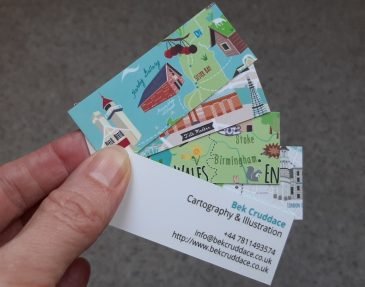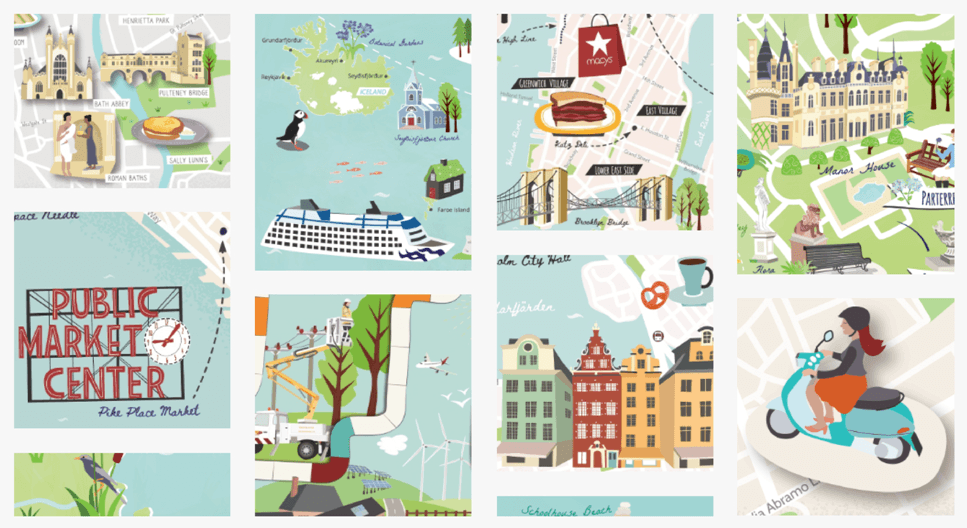
Starting out as a Freelance Illustrator – Part 1
- by Bek Cruddace
- in Advice Creative
- posted October 14, 2018
Recently I’ve been asked a few times about how I started working as a freelance illustrator. So I decided to write this post to help anyone asking the same questions. Below is by no means an exhaustive list. It’s based on what I experienced in the years I’ve been working for myself and it’s what I wish I’d known when I first started out. If you’re considering starting your own freelance illustration business I hope you find this helpful.
A friend once expressed surprise that I didn’t ‘just work on a laptop in the dining room’. I hope this post dispels some of that way of thinking.
Somewhere to Work
You will need an actual physical place to work and store all your work related paraphernalia. These two places don’t have to be next to each other but you will need them both.
If you’re lucky like me you will have a room to call your own.
If you don’t have the luxury of your own office is there a section of a room/entrance hall that can become a dedicated space for your desk? – Ideally one away from the grabby little hands of children – although with 3 children of my own I appreciate this is easier said than done.
Apart from an actual work space you will need storage for your work ‘stuff’ such as:
- Filing/receipts that show all the financial incoming & outgoings for your business for at least 5 years (please note this is recommended by HMRC in the UK, it may differ in other countries).
- Archive work & commissions.
- Packaging & stock if you intend to sell your illustrations/cards etc (don’t underestimate how much a 3 boxes of 12 A2 cardboard tubes can take up.)
- Drawing paper, paints, a drawing board etc
You get the idea; the list of work related ‘stuff’ you can accrue is long.
Some people choose to rent out office space in a unit or co-operative. I’ve never done this so I can’t really comment. What you gain in camaraderie and keeping work and home physically separate I guess you lose in the cost and commute.
Apparently, some people can run a business from a stylish coffee shop, using a neat looking MacBook with a child perched on their knee but as far as I can see this is a myth. I’ve never met anyone who did this, in fact I think they only exist on TV. This brings me onto my next point….

Time to Work
This is possibly even more obvious than my first point but as someone who was used to multi-tasking it took a while for the penny to drop.
You will need to give yourself time to work. You will need uninterrupted time and if necessary you may have to extract time from other activities, like sleeping.
When I first started working for myself my youngest was only 2 years old. For more than a year I got up at 5.30 to get 2 hours in before ‘children getting up time’. I’m not going to pretend that this was great & empowering in any way, it wasn’t, it was totally rubbish. But it meant I had 10 extra hours a week to work uninterrupted & it enabled me to build good foundation for my business.
To work effectively you need serious, dedicated work time. Not work time while you’re caring for children, or watching TV. If you have children you will definitely need some childcare, either that or prepare to have a nervous breakdown.

Hardware and Software
Illustration hardware and software needs depend largely on how you work and is largely down to budget, but it goes without saying you need a reliable setup.
You will also need to organise yourself regarding invoices and record keeping. I keep it simple and use Excel to record all my finances & Word to produce invoices/quotes. You may prefer an online booking keeping option and to design your invoices in InDesign. It’s really down to personal preference, but initially I would recommend getting something organised quickly and cheaply. Once your illustration commissions come rolling in and you’re more established you can always update.

Portfolio Website

You will need a portfolio website to advertise you’re work, let the world know that you’re open and ready for business and to show potential clients ho to contact you. There are lots of places you can get a free to very cheap website. It doesn’t need to be fancy just professional and easy to use.

Email and Business Cards
 When you set up your website the chances are you will also have the chance to set up numerous email accounts under the same domain. I think it’s always a good idea to use that rather than a Gmail or, God forbid, a Hotmail account. It just looks a lot more professional. Also, don’t forget to get some business cards printed.
When you set up your website the chances are you will also have the chance to set up numerous email accounts under the same domain. I think it’s always a good idea to use that rather than a Gmail or, God forbid, a Hotmail account. It just looks a lot more professional. Also, don’t forget to get some business cards printed.
When I first started out working for myself I inwardly cringed every time I handed out a business card. But if you want potential clients to remember you, distributing a few well designed cards could make all the difference. I use Moo mini cards and carry some in a felt key ring so I always have some with me.

Tax
Register yourself with HMRC (if you’re in the UK) or with whoever the tax body is in the country where you live. If you don’t, the tax man will find out and you will face penalties. It may seem a bit scary at first, but it’s not difficult to do. You will be sent a unique ID number & a password so you can login to your records & do your tax return online.
I do my own tax return. It isn’t difficult as long as you are organised and record all your financial incomings & outgoings as you go along. Online you can start and save it and come back to the return as and when you like. Believe me if I can do it anyone can. I have trouble with my children’s primary level maths – something I’m not proud of.

Insurance
Who would have thought you’d need to have indemnity insurance for freelance illustration? Some clients will insist on it. But if you have people visit you in your home/office you need insurance. You need to be covered if:
- a client visits your office and they fall down your stairs because of that ball the cat left at the top.
- If you visit your clients in their office you need to be covered when you accidentally spill coffee on their new super-duper laptop.
- Even if you never go out and only communicate with your clients over email you need to make sure your illustrations don’t show something inaccurate likely to damage a client’s reputation and that will leave yourself wide open to prosecution.
Some people also choose to take out insurance against illness & injury in case they can’t work.

Lots of Hard-work
Some people think that if you are freelance then most of the day is spent relaxing at home watching ‘Homes under the Hammer’ and eating chocolate digestives. Sorry to be the bearer of bad news but if you want to make a success of your freelance illustration business then you are going to have to work your socks off. Until that is you have some sort of client base and a more regular workload, then you can just work very hard. The thing about working for yourself as opposed to working for a someone else is that you have to do EVERYTHING. You don’t just get to do the lovely drawing design stuff, you also have to:
- Promote your work,
- Find new business opportunities,
- Follow up existing clients,
- Quote & follow up said quotes
- Invoice & make sure your invoices are all paid on time.
- File all relevant legal documents such as tax returns, receipts, expenses etc
- Get professional insurance
- Keep you online presence ‘relevant’ & up to date.
- Do actual design work.
There’s probably more, I’m getting exhausted just thinking about it, but I think you get the idea.

Self Belief and a Positive Attitude
Last and by no means least this is what you need from the word go when starting out as an independent illustrator.
In Part Two I’ll be looking at How to find work as a Freelance Illustrator…..
This article first appeared in October 2017

